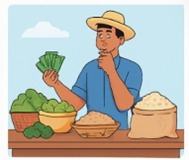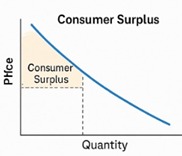Agricultural Economics is more than just a subject—it’s the heart of understanding how people make food-related choices and how those choices impact markets, prices and welfare. In today’s blog, we’ll take a closer look at three key concepts: Consumer’s Equilibrium, Derivation of the Demand Curve and the Concept of Consumer Surplus. Let’s make these topics engaging, interactive and absolutely clear!
🌾 What is Consumer’s Equilibrium in Agricultural Economics?
Imagine you’re a farmer visiting a weekly mandi with ₹500 in your pocket. You’re trying to decide between buying wheat, rice or vegetables. Consumer’s equilibrium is that sweet spot where your budget is fully utilized and your satisfaction (or utility, as economists call it) is maximized.
🔍 The Theory Behind It
In economic terms, a consumer is in equilibrium when the marginal utility per rupee spent on each good is equal. That means:
MUx/Px = MUy/Py = MUz/Pz
Where:
- MU = Marginal Utility (extra satisfaction)
- P = Price of the good
- x, y, z = different goods
🧠 Quick Example:
If a kg of rice gives you 10 units of satisfaction and costs ₹20, its utility per rupee is 0.5.
If a kg of wheat gives 8 units of satisfaction and costs ₹10, its utility per rupee is 0.8.
You’re clearly getting more “bang for your buck” with wheat, so you’ll adjust your consumption until the ratio is balanced. That’s equilibrium!
📉 Derivation of Demand Curve in Agricultural Economics
So how do we get from utility to the demand curve?
Here’s where it gets interesting.
🪄 Step-by-Step Derivation
- Start with Consumer Equilibrium: As the price of a good decreases, the marginal utility per rupee increases.
- Adjusting Consumption: To maintain equilibrium, the consumer increases the quantity demanded.
- Plotting the Points: For each price level, note the corresponding quantity demanded.
- Join the Points: Voilà! You get the downward-sloping demand curve.
This curve shows the inverse relationship between price and quantity demanded—a foundation of economic theory.
Real-life example in Agriculture: If the price of onions drops from ₹40/kg to ₹20/kg, households may buy more onions—not just to eat today, but to store, pickle or share. That’s the demand curve in action!
Concept of Consumer Surplus: Now, let’s talk about consumer surplus, a hidden gem in economic welfare.
What is Consumer Surplus?
It’s the extra benefit a consumer gets when they’re willing to pay more for a product than they actually do.
Formula: Consumer Surplus = Willingness to Pay – Actual Price Paid
In Agriculture: Suppose you’re willing to pay ₹100 for a premium organic mango, but you get it for ₹70. That ₹30 is your consumer surplus—your hidden satisfaction.
Multiply this across thousands of buyers and you understand how lower prices can benefit consumers massively—especially in agricultural markets where price fluctuations are common.
💬 Let’s Make It Interactive!
🔸 Think like a Consumer: What’s one item you buy where you feel you’re getting more value than the price? Share it in the comments!
🔸 Question for You: If the price of milk falls by ₹10, do you buy more? Why or why not?
Understanding Agricultural Economics: Consumer’s equilibrium and derivation of demand curve, concept of consumer surplus isn’t just for exam preparation—it’s about understanding how real people make real decisions in real markets.
From your local vegetable vendor to national pricing policies, these concepts shape the entire agricultural economy. Whether you’re a student, educator or simply curious about economics in farming—mastering these basics gives you a powerful lens to view the world of agri-markets.
Bonus Tip:
Want to remember this easily?
E.D.S. Formula:
Equilibrium → Demand Curve → Surplus
Bookmark this post and refer back during your next study session or while prepping for ICAR, IBPS-AFO, or state-level agri exams!
MCQs: Test Your Understanding
Question 1:
In consumer equilibrium, the consumer is said to be maximizing utility when:
(a) Total utility is equal for all goods
(b) Marginal utility of each good is zero
(c) Marginal utility per rupee spent is equal across all goods
(d) Price of all goods is the same
(e) Marginal cost equals marginal revenue
Answer: (c)
Solution: Consumer equilibrium occurs when MUx/Px = MUy/Py = MUz/Pz.
Question 2:
If the price of a good falls and the consumer increases quantity demanded, this reflects:
(a) Law of diminishing marginal utility
(b) Consumer surplus
(c) Demand contraction
(d) Derivation of demand curve
(e) Law of supply
Answer: (d)
Solution: The derivation of demand curve shows inverse relation between price and quantity demanded.
Question 3:
Which of the following best defines Consumer Surplus?
(a) Total utility minus marginal utility
(b) Utility obtained from last unit consumed
(c) Price paid minus willingness to pay
(d) Willingness to pay minus actual price paid
(e) Total expenditure minus total income
Answer: (d)
Solution: Consumer Surplus = Willingness to Pay – Actual Price Paid
Question 4:
If a consumer is getting more marginal utility per rupee from rice than from wheat, what should they do?
(a) Buy more wheat
(b) Raise the price of rice
(c) Stop buying both
(d) Buy more rice and less wheat
(e) Wait for prices to change
Answer: (d)
Solution: To reach equilibrium, consumer shifts consumption to maximize satisfaction.
Question 5:
Which of the following statements is false about demand curve?
(a) It slopes downward from left to right
(b) It shows inverse relation between price and demand
(c) It reflects supply conditions in market
(d) It is derived from consumer equilibrium
(e) It helps in determining consumer surplus
Answer: (c)
Solution: Demand curve reflects demand side behaviour, not supply.
FAQs: Quick Clarifications
Q1. Is Consumer’s Equilibrium only applicable to two goods?
Answer: Not necessarily. It is commonly explained with two goods for simplicity, but it applies to multiple goods as long as marginal utility per rupee is equalized across all.
Q2. How is the demand curve related to utility?
Answer: As price decreases, the marginal utility per rupee increases. To restore equilibrium, more quantity is consumed, which gives the downward slope of demand curve.
Q3. Can Consumer Surplus be zero?
Answer: Yes, it can be zero if the price paid equals the willingness to pay. It’s usually positive in real markets due to price differences and perceived value.
Q4. What real-life factors affect consumer equilibrium in agriculture?
Answer: Factors include income levels, prices of substitutes, government subsidies, preferences, and seasonal availability of produce.
Q5. Why is Consumer Surplus important for farmers and policymakers?
Answer: It helps understand consumer benefits and welfare, which can guide pricing policies, subsidy programs, and market interventions to ensure food affordability.
Want More Exam-Oriented Blogs? Stay tuned to our blog series focused on AFO and ICAR Exams preparation, Agri-Business and Agricultural Economics’ fundamentals. For queries or topic requests, drop them in the comments below!








